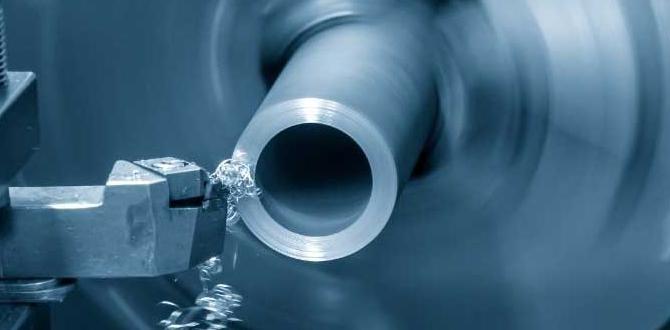Carbide end mills offer superior hardness and heat resistance for cutting tough tool steels, providing faster material removal and longer tool life compared to traditional high-speed steel. This guide breaks down how to choose and successfully use them for your projects.
Welcome to Lathe Hub! Ever looked at a piece of tough tool steel and wondered what kind of cutter could tackle it without breaking a sweat? Tool steels are fantastic for making durable parts, but they can be a real pain to machine. That frustration is something many of us in the workshop face. But don’t worry, there’s a tool that makes cutting these hard materials so much easier than you might think: the carbide end mill. In this guide, I’ll walk you through what makes them so good and how to use them effectively, especially for those tricky tool steels. Let’s get your milling projects done right and with confidence!
What is a Carbide End Mill?
An end mill is a type of cutting tool used in milling machines to create complex shapes and cuts in materials. Think of it like a drill bit that can also move sideways. When we talk about a “carbide end mill,” the key word is “carbide.” This refers to the material the cutting edges are made from – tungsten carbide.
Tungsten carbide is a composite material made by pressing and sintering tungsten carbide powder with a binder (usually made of cobalt). This process creates a material that is incredibly hard, much harder than traditional tool steels used for cutting tools. This extreme hardness is what gives carbide end mills their incredible performance, especially when cutting tough materials like “tool steel D2”.
Compared to High-Speed Steel (HSS) end mills, carbide offers significant advantages:
- Superior Hardness: Carbide is significantly harder than HSS, meaning it can maintain a sharp edge at higher temperatures and speeds.
- Better Heat Resistance: Machining generates heat. Carbide can withstand much higher temperatures before losing its cutting ability, which is crucial for tough materials.
- Higher Cutting Speeds: Because carbide is so hard and heat-resistant, you can often use much faster spindle speeds and feed rates, leading to quicker machining times.
- Longer Tool Life: For the right application, carbide end mills can last many times longer than HSS tools.
You’ll find carbide end mills in a huge variety of shapes, sizes, and flute configurations. For our discussion on tool steel, we’re often interested in specific types designed for difficult materials, like a “carbide end mill 1/4 inch 1/4 shank stub length.” This tells us the diameter (1/4 inch), the shank diameter (also 1/4 inch, meaning it’s a straight shank), and its length – “stub length” means it’s shorter than a standard end mill. Shorter tools are often more rigid, which is great for reducing chatter and improving surface finish when cutting hard materials.
Why Carbide is King for Tool Steel
Tool steels are designed to be just that – tough. They are alloyed with elements like chromium, molybdenum, vanadium, and tungsten to increase their hardness, wear resistance, and ability to hold an edge, even at elevated temperatures. This makes fantastic for making dies, molds, cutting tools, and other components that need to withstand significant stress and wear. However, this inherent toughness also makes them notoriously difficult to machine.
When you try to cut tool steel with a standard HSS end mill, a few things can happen. The HSS tool can quickly become dull due to the material’s hardness. This heat build-up can even “soften” the tool’s cutting edge. A dull tool will rub rather than cut, generating even more heat, and can lead to poor surface finish, difficulty in holding tolerances, and potentially even catastrophic tool failure (breakage).
This is where carbide end mills shine. Their inherent hardness allows them to cut through the tough structure of tool steels without losing their edge as quickly. Their superior heat resistance means they can handle the temperatures generated during the cutting process far better than HSS. This allows us to use higher cutting speeds and feed rates, meaning:
- Faster Machining: You can get parts done in a fraction of the time compared to using HSS.
- Better Results: Because the tool stays sharp for longer, you’ll achieve better surface finishes and more accurate dimensions.
- Reduced Tooling Costs (in the long run): While carbide tools might have a higher upfront cost than HSS, their longer lifespan and increased productivity often make them more economical for production or repeat work.
For a material like “tool steel D2,” which is known for its excellent wear resistance and toughness, a carbide end mill is almost always the preferred choice for efficient machining. D2 is a high-carbon, high-chromium tool steel that requires a robust cutting tool to effectively remove material.
Choosing the Right Carbide End Mill for Tool Steel
Not all carbide end mills are created equal, and choosing the right one for your specific task, especially when dealing with tool steels, is crucial. Let’s break down the key factors:
1. End Mill Material (Carbide Grade)
Carbide itself isn’t just one thing. It’s made up of fine grains of tungsten carbide held together by a binder, typically cobalt. The “grade” of carbide refers to the size of these grains and the proportion of binder:
- Submicron or Ultrafine Grain Carbide: These have very small carbide grains and a higher percentage of binder. They are extremely hard and wear-resistant, making them ideal for cutting hard materials like hardened steels and tool steels. They tend to be more brittle, so they are best used where chatter is minimal.
- Fine Grain Carbide: A good all-around choice, offering a balance of hardness, toughness, and wear resistance. Suitable for a wide range of materials, including tool steels.
- Coarse Grain Carbide: These have larger grains and less binder. They are tougher and more resistant to chipping but are less wear-resistant. Less common for high-performance tool steel machining.
For “tool steel D2,” a submicron or fine-grain carbide end mill is generally recommended for optimal performance.
2. Number of Flutes
Flutes are the spiral grooves on the end mill that carry away chips. The number of flutes impacts its cutting ability and chip evacuation:
- 2 Flutes: These are great for plunging (drilling into the material), slotting, and working with softer, gummy materials where chip evacuation is crucial. They offer more chip room.
- 3 Flutes: A good compromise. They can handle slotting and profiling and offer better rigidity than 2-flute. Often a good starting point for many applications.
- 4 Flutes: Generally offer the best rigidity and are excellent for profiling, face milling, and general-purpose machining. They are very stable but have less chip clearance than 2 or 3-flute. When machining hard materials like tool steel, rigidity is often a high priority to prevent chatter.
- More than 4 Flutes (e.g., 5, 6, 7): These are typically high-performance end mills designed for specific materials and high-speed machining, often with specialized geometries for excellent surface finish. They have very little chip room and require significant power and coolant to run efficiently.
When working with “tool steel D2,” a 3 or 4-flute end mill is often a good choice. If you’re doing a lot of slotting and need to manage chips, a 2-flute might be considered, but you’ll need to be mindful of feed rates to avoid clogging. For general profiling, a 4-flute offers excellent stability.
3. Geometry and Design
Beyond the number of flutes, the specific design of the end mill matters:
- Square End Mills: These have flat ends and are used for creating 90-degree corners, pockets, and general milling. This is the most common type.
- Ball End Mills: These have rounded ends, perfect for creating contoured surfaces, 3D shapes, and fillets.
- Corner Radius End Mills (“Fillet” or “Chamfer”): These have a slight radius or chamfer on the corner. They provide a stronger corner than a square end mill and help reduce stress at the corner, leading to less chipping and breakage. These are highly recommended for cutting tool steels.
- Center Cutting vs. Non-Center Cutting: A center-cutting end mill has cutting edges that extend to the very tip, allowing it to be plunged straight into the material. A non-center-cutting end mill does not cut at the tip and cannot be plunged.
- Convexity/Concavity: Some end mills have specialized flute forms to create specific shapes.
- Chip Breaker/Chip Ejector Features: You might see end mills with serrations or special flute designs aimed at breaking chips into smaller, more manageable pieces for better evacuation. This is very useful for tougher materials.
For a “carbide end mill 1/4 inch 1/4 shank stub length” intended for tool steel, I’d look for a center-cutting tool with a corner radius or a high-performance design with chip-breaking features. A stub length is beneficial for rigidity.
4. Shank Type and Length
As mentioned, a 1/4 inch shank is common. A “stub length” end mill is shorter than standard. Shorter tools have less overhang, which means less deflection and vibration. This increased rigidity is critical for cutting hard materials like tool steel, as it helps prevent chatter and improve accuracy.
A 1/4 inch shank is a standard size, readily available in collets and tool holders. The stub length will reduce the overall reach but significantly increase rigidity.
5. Coatings
Coatings are applied to the surface of the end mill to further enhance its performance. For machining steel and tool steel, common and effective coatings include:
- TiN (Titanium Nitride): A golden-colored coating that increases surface hardness and reduces friction, offering moderate improvements in tool life and cutting speeds. Good for general-purpose steel machining.
- TiCN (Titanium Carbonitride): A gray/black coating that is harder than TiN and offers better wear resistance, especially in abrasive applications. Excellent for steels.
- AlTiN (Aluminum Titanium Nitride): A dark purple/black coating that forms a hard, protective aluminum oxide layer at high temperatures. This makes it exceptionally good for high-speed machining and high-temperature applications, making it ideal for tool steels. It performs best with air blast or minimum quantity lubrication (MQL), as flood coolant can sometimes hinder the formation of the protective oxide layer.
- TiB2 (Titanium Diboride): A newer, extremely hard coating that offers excellent performance in abrasive materials and stainless steels.
For tool steels like D2, an AlTiN coating is often a top performer due to its ability to handle the high heat generated. However, it’s important to choose a coating that is compatible with your coolant strategy (if any).
Chip Evacuation Considerations for D2 Steel
When machining steels, especially tough ones like D2, chip evacuation is a major concern. If chips aren’t removed quickly from the cutting zone, they can:
- Re-cut, leading to a poor surface finish.
- Weld onto the cutting edge, dulling the tool rapidly.
- Clog the flutes, leading to tool breakage.
- Increase heat buildup, further stressing the tool and workpiece.
For a “carbide end mill 1/4 inch 1/4 shank stub length for tool steel D2 chip evacuation,” you should look for:
- 2 or 3 Flutes: Offer more chip room than 4-flute end mills.
- Polished Flutes: Smoother flutes help chips slide out more easily.
- Open Flute Design: Some end mills have a more open helix angle to maximize chip clearance.
- Chipbreaker Features: Serrations or small steps along the cutting edge help break chips into smaller pieces.
Using an appropriate coolant or lubricant is also paramount for chip evacuation and cooling. A strong, directed coolant stream (or MQL) can blast chips away from the cutting zone.
Safe and Effective Use of Carbide End Mills
Using carbide end mills, especially on tough materials, requires attention to detail for both safety and achieving good results. Here’s how to make sure you get the most out of yours:
1. Setup and Workholding
This is arguably the most critical part. A well-held workpiece and a rigid tool holding system are essential.
- Rigid Workholding: The workpiece must be clamped down extremely securely. Use a vise with hardened jaws if possible, or directly bolt the workpiece to the machine table using T-nuts and clamps. Any movement of the workpiece will likely lead to tool breakage.
- Rigid Tool Holding: Use a high-quality collet chuck or a Weldon shank holder. A standard ER collet can work, but a dedicated milling chuck or a holder designed for carbide tools often provides superior runout and clamping force. Ensure the shank of the end mill is fully gripped by the holder. “A 1/4 inch shank” fits into a 1/4 inch collet, but ensure it’s seated properly.
- Minimize Spindle Overhang: Use the shortest tool stick-out (length of end mill extending from the collet/holder) possible. This is where a “stub length” end mill has a huge advantage. Less overhang means less deflection, less vibration, and a more rigid setup.
- Check Runout: Ensure your tool holder and collet have minimal runout. Excessive runout on even a tiny “1/4 inch shank” tool will cause uneven cutting, vibration, and premature tool failure when cutting hard materials.
2. Setting Cutting Parameters (Speeds and Feeds)
This is where carbide truly excels, but it also requires a bit of calculation. You’ll need to find the manufacturer’s recommended cutting speeds for the specific carbide end mill and material you are using. These are usually provided in surface feet per minute (SFM) or meters per minute (m/min).
Here’s a simplified look:
Spindle Speed (RPM):
RPM = (SFM x 3.82) / Diameter (inches)
For example, if your end mill’s recommended SFM is 300 SFM and the diameter (D) is 1/4 inch (0.25):
RPM = (300 x 3.82) / 0.25 = 1146 / 0.25 = 4584 RPM
Feed Rate (IPM – Inches Per Minute):
Feed Rate = RPM x (.001 to .010) x Number of Flutes x Chip Load per Tooth
The “chip load per tooth” is a critical value, often provided by the tool manufacturer. It’s the thickness of the chip each cutting edge removes. For example, a 1/4 inch end mill might have a chip load of 0.001 to 0.003 inches per tooth for tool steel.
Let’s use our example RPM of 4584, 4 flutes, and a chip load of 0.002 inches per tooth:
Feed Rate = 4584 x 4 x 0.002 = 36.67 IPM
Important Notes on Speeds and Feeds:
- Start Conservatively: Always start with conservative settings (lower end of recommended speeds and feeds) and listen/watch the cut.
- Listen to the Machine: A good cut sounds like a series of crisp “chips





